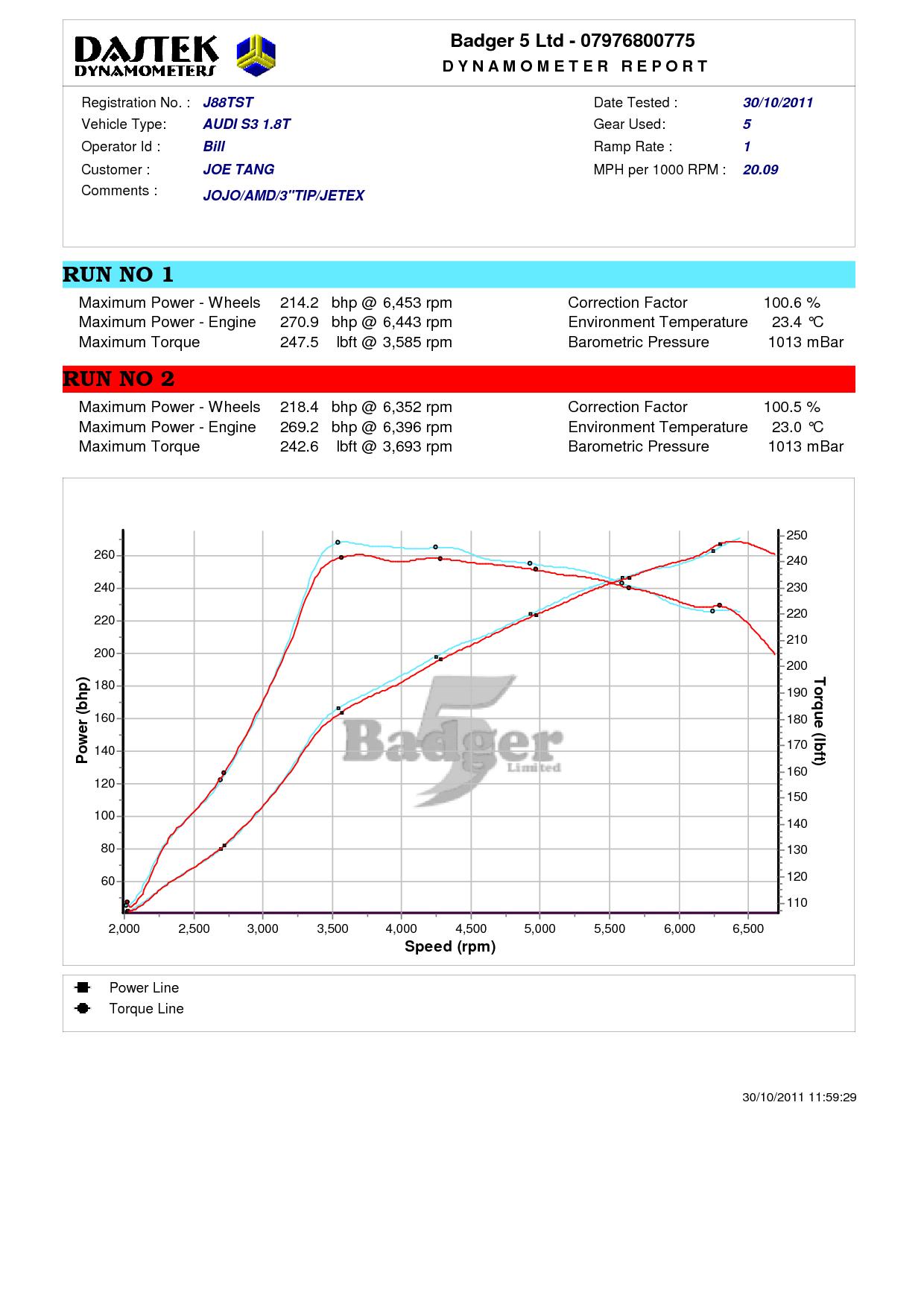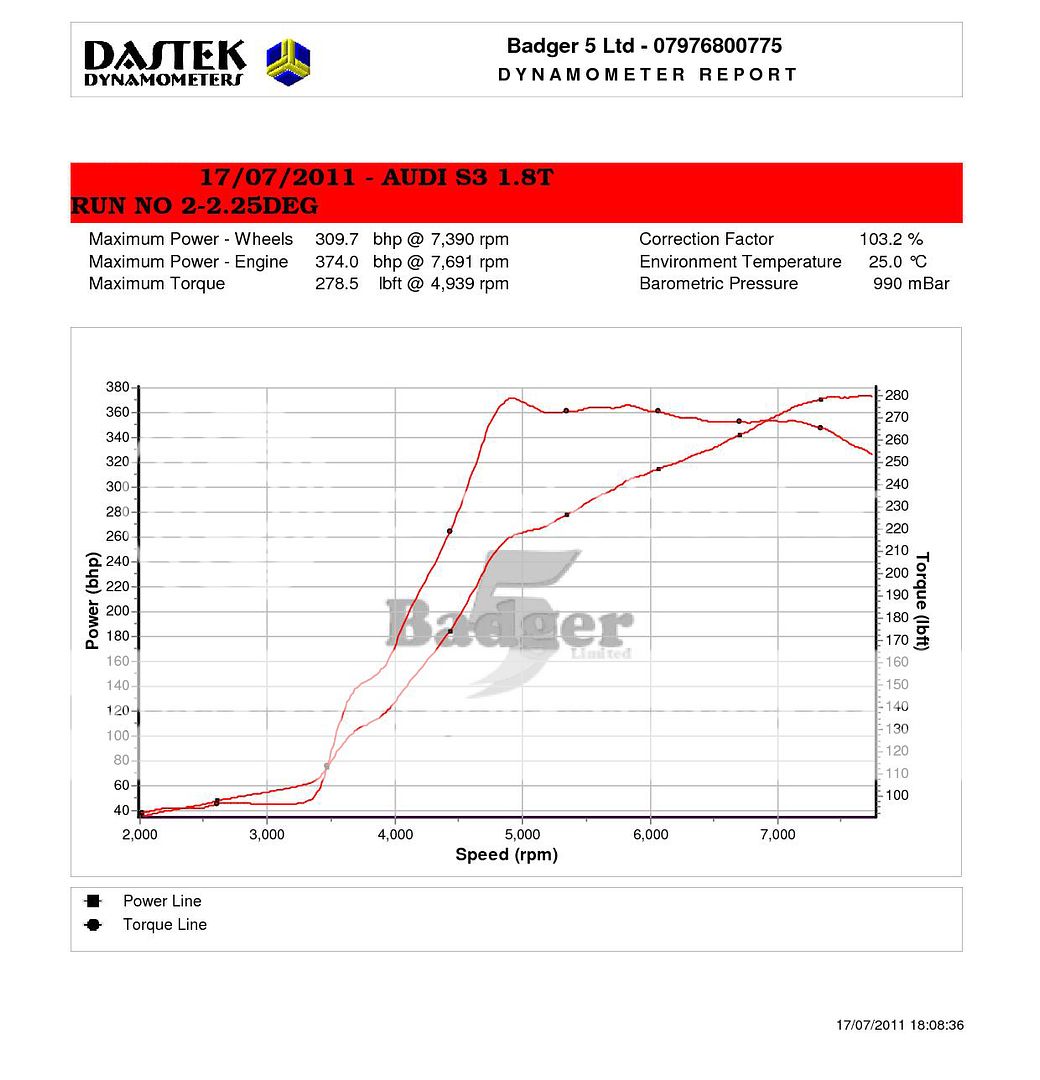Audi S3 8L % drivetrain loss
- Thread starter Jimgrim77
- Start date
You are using an out of date browser. It may not display this or other websites correctly.
You should upgrade or use an alternative browser.
You should upgrade or use an alternative browser.
- Joined
- Dec 8, 2006
- Messages
- 12,100
- Reaction score
- 4,340
- Points
- 113
- Location
- Eastleigh
- Website
- twitter.com
I don't have a figure, but I reckon it's a whole load more than that!
I'm sure when glen did all his testing, 275bhp at the flywheel was only around 200 at the wheels or so.....
4wd losses are big
I'm sure when glen did all his testing, 275bhp at the flywheel was only around 200 at the wheels or so.....
4wd losses are big
- Joined
- Sep 14, 2008
- Messages
- 24,836
- Reaction score
- 6,078
- Points
- 113
- Location
- Wibbleton
- Website
- www.tuffty.co.uk
Drivetrain losses are subjective at best... I have seen wildly varying figures on the dyno on fwd and haldex awd cars in the past... also depends on things like how warm the drive train is, grip of the tyres etc... it varies from run to run too as things warm up... you see higher WHP but less coastdown loss as things warm up... doesn't effect the final output of course as its relative
This dyno plot of JoJo's S3 from a recent dyno day at Bill's highlights the issue...

56.7hp (26.47%) loss on the first run, 50.8hp (23.26%) on the second...
Here is a run on mine...

64.3hp difference which equates too 20.76% loss
<tuffty/>
This dyno plot of JoJo's S3 from a recent dyno day at Bill's highlights the issue...

56.7hp (26.47%) loss on the first run, 50.8hp (23.26%) on the second...
Here is a run on mine...

64.3hp difference which equates too 20.76% loss
<tuffty/>
Last edited:
Drivetrain losses are subjective at best... I have seen wildly varying figures on the dyno on fwd and haldex awd cars in the past... also depends on things like how warm the drive train is, grip of the tyres etc... it varies from run to run too as things warm up... you see higher WHP but less coastdown loss as things warm up... doesn't effect the final output of course as its relative
This dyno plot of JoJo's S3 from a recent dyno day at Bill's highlights the issue...

56.7hp (26.47%) loss on the first run, 50.8hp (23.26%) on the second...
Here is a run on mine...

64.3hp difference which equates too 20.76% loss
<tuffty/>
Thanks.
So...more like 20-23% then based on your sample of two. Mine is likely to be the higher end as it looks similar in spec to jojo's but again it's all subjective.
What's interesting is that, despite greater power, your drivetrain loss is actually less as a percentage of your power. My assumption would have been the other way around and incorrect as a result.
I'm keen to measure speed across a variety of distances from standing start and test it on the track with the iphone mounting and require a drivetrain loss measurement for more accurate reading. I'm on a rolling road thursday, so will measure it then before popping to castle combe then.
- Joined
- Sep 4, 2003
- Messages
- 29,115
- Reaction score
- 3,862
- Points
- 113
- Location
- Solihull, Midlands
- Website
- www.audi-sport.net
Thanks.
So...more like 20-23% then based on your sample of two. Mine is likely to be the higher end as it looks similar in spec to jojo's but again it's all subjective.
What's interesting is that, despite greater power, your drivetrain loss is actually less as a percentage of your power. My assumption would have been the other way around and incorrect as a result.
I'm keen to measure speed across a variety of distances from standing start and test it on the track with the iphone mounting and require a drivetrain loss measurement for more accurate reading. I'm on a rolling road thursday, so will measure it then before popping to castle combe then.
The 20-23% you are reffering to is in 2wd mode by the way, if you get your car RRd in 4wd mode, the transmision losses is more!
TDIQ
8L > 8P > 8V
- Joined
- Jul 26, 2009
- Messages
- 776
- Reaction score
- 6
- Points
- 18
I'd be interested to see if anyone has come to an average figure for a Gen 1 Haldex car based on a launch which engages 4wd to get off the line.
I found Dynolicious to be pretty useless, obviously it is more useful on a car that drives the same axles all the time. See here for some comparions to a VBox.
I found Dynolicious to be pretty useless, obviously it is more useful on a car that drives the same axles all the time. See here for some comparions to a VBox.
- Joined
- Sep 14, 2008
- Messages
- 24,836
- Reaction score
- 6,078
- Points
- 113
- Location
- Wibbleton
- Website
- www.tuffty.co.uk
Thanks.
So...more like 20-23% then based on your sample of two. Mine is likely to be the higher end as it looks similar in spec to jojo's but again it's all subjective.
What's interesting is that, despite greater power, your drivetrain loss is actually less as a percentage of your power. My assumption would have been the other way around and incorrect as a result.
I'm keen to measure speed across a variety of distances from standing start and test it on the track with the iphone mounting and require a drivetrain loss measurement for more accurate reading. I'm on a rolling road thursday, so will measure it then before popping to castle combe then.
Any BHP figures that any of these ODBII logging tools produce should be taken with a pinch of salt... most are based on airflow/load readings from the ECU or a rough calc based on how heavy you say the car is and the GPS readings from 0-60 or 0-100 etc...
Even dyno's are subject to dyno lottery... if you have a dyno local to you I would suggest yo stick wit that one while you modify your car then at least you will have plots for relative gains...
Dyno Dynamics dynos use a calculation rather than coastdown losses to guesstimate flywheel power...
Point I am trying to make is regardless of how you get the figure, don't get hung up on it
<tuffty/>
- Joined
- May 28, 2004
- Messages
- 10,217
- Reaction score
- 2,385
- Points
- 113
- Location
- nr Glos
- Website
- www.badger5.co.uk
- Joined
- May 28, 2004
- Messages
- 10,217
- Reaction score
- 2,385
- Points
- 113
- Location
- nr Glos
- Website
- www.badger5.co.uk
haldex cars are only 4wd when the need arises, front wheel slipping etc...
still turning the diff in terms of drag etc
still turning the diff in terms of drag etc
C
colicabcadam
Guest
whilst on the subject i thought i'd also point out that although fwd cars put more power down on a dyno when compared to awd cars, what everyone fails to think of is the fact that the rear wheels on a fwd will create drag / resistance, which a dyno will not show.....
therefor the advantage of a fwd on a dyno over a awd on a dyno means nothing in the real world
therefor the advantage of a fwd on a dyno over a awd on a dyno means nothing in the real world
- Joined
- Sep 4, 2003
- Messages
- 29,115
- Reaction score
- 3,862
- Points
- 113
- Location
- Solihull, Midlands
- Website
- www.audi-sport.net
whilst on the subject i thought i'd also point out that although fwd cars put more power down on a dyno when compared to awd cars, what everyone fails to think of is the fact that the rear wheels on a fwd will create drag / resistance, which a dyno will not show.....
therefor the advantage of a fwd on a dyno over a awd on a dyno means nothing in the real world
My powerplots was done in fwd mode with the Haldex unplugged, and it also measured it's transmission losses during the coastdown after the power run.
- Joined
- May 28, 2004
- Messages
- 10,217
- Reaction score
- 2,385
- Points
- 113
- Location
- nr Glos
- Website
- www.badger5.co.uk
whilst on the subject i thought i'd also point out that although fwd cars put more power down on a dyno when compared to awd cars, what everyone fails to think of is the fact that the rear wheels on a fwd will create drag / resistance, which a dyno will not show.....
therefor the advantage of a fwd on a dyno over a awd on a dyno means nothing in the real world
The facts/reality is if they are fwd or 4wd on a dyno which measures, the power should be the Same shoudl it not, if all allowances are being measured and taken into account.
In the example of drag etc with a haldex car on a 2wd rollers, the rear diff is not turning so its drag is not occuring like it would be on a real road.
Less variables in 2wd than 4wd, in terms of temperature of diffs, oil viscosities etc between runs.
awd are heavier in the real world.. so if comparing power to weight, your shafted. lighter, same power car will be the one accelerating away.
Last edited:
- Joined
- Sep 14, 2008
- Messages
- 24,836
- Reaction score
- 6,078
- Points
- 113
- Location
- Wibbleton
- Website
- www.tuffty.co.uk
... so if comparing power to weight, your shafted. lighter, same power car will be the one accelerating away.
Yeah... seen that first hand lol... ****** Lupo!!
<tuffty/>
Rosso TT
Registered User
- Joined
- Jun 4, 2011
- Messages
- 146
- Reaction score
- 3
- Points
- 18
- Location
- West Gippsland, Victoria Australia
Interesting. Thanks all. I'm hearing around 20-23% as a general approximation.
I'm on a rolling road tomorrow to measure how much/ little power I have after 3 years of various mods.
It should be interesting. I'll post my results when I have them.
I'm on a rolling road tomorrow to measure how much/ little power I have after 3 years of various mods.
It should be interesting. I'll post my results when I have them.




